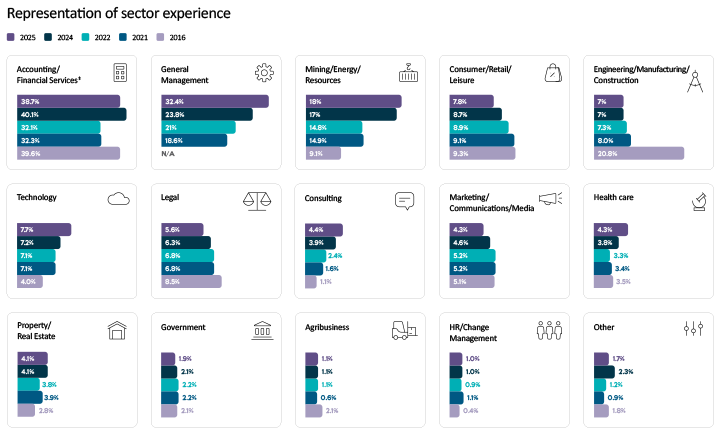The 2025 Board Diversity Index, presenting the survey results of the ASX300 companies, has been recently released. Now in its 11th year, the report published by Watermark and the Australian Institute of Company Directors (AICD) highlights significant changes in board diversity trends in Australia. This article provides an overview of their findings and others, offering insights into potential implications for individuals seeking a board appointment.
I will note that the Board Diversity Index, and hence the majority of the statistics and trends I refer to here, are based on data collected from the boards of ASX300 publicly listed companies. Government boards, not-for-profit boards, and private company boards are likely to have different statistics and trends. However, in many cases, particularly in the private sector, it is challenging to collate and compare similar data as it is not publicly available.
The representation of genders on Australian boards
In 2025, female representation on Australian ASX 300 boards continued to exceed the 30% benchmark. The number of all-male boards decreased to just 11, meaning that 73% of boards now have more than 30% women directors. The 11 years of Diversity Index Data have seen the number of ASX300 board seats that are held by women increase from 399 in 2016 to 781 this year. As the female talent pool continues to expand, the ratio of men to women on boards is expected to approach parity by 2030.
Gender diversity data is available for Australian Federal Government boards due to the government’s commitment to gender balance and transparency. The statistics reported in the latest Gender Balance on Australian Government Boards Annual Report 2023-2024 highlight the federal government’s ongoing commitment to gender diversity, not only in the workplace but also at the board level. This 2023-2024 reporting period saw new records set, with 54.4% of Australian Government board positions held by women and 45.3% of Chair and Deputy Chair positions held by women.
The age diversity of directors in Australia
2025 has seen little movement in the age diversity of ASX300 directors. The average age remains 61 years, with a minimal age difference between the genders. The average age for men is 62.1 years, and for women, it is 59 years. The youngest director is 30 years old, and the oldest is 85 years old. These figures have remained relatively stable in recent years, with no rapid changes anticipated as the population ages. However, it will be intriguing to observe how dynamics shift as these aging directors retire and Gen Z leaders, known for their technological proficiency and adaptability to fast-paced changes, are ushered in to replace them.
The cultural diversity of Australian directors remains unsatisfactory
As another year passes, we continue to observe a significant lack of cultural diversity on ASX300 boards, with 92% of Directors being Anglo-Celtic – a slight increase from 2024. This is a long way from being an accurate representation of the generations of multicultural Australia, nor in line with the general population trends, which show a growing proportion of Australians of Asian and Indian descent.
There has also been very little change in the representation of indigenous Australia on ASX300 boards. This year saw just one new indigenous director appointed, making the total just 5 directors holding 7 seats.
Director skills, experience & qualifications
Whilst skills and experience may not come to mind when you consider traditional strains of diversity, when it comes to managing the top companies in Australia (and many other organisations), a diversity of skills is required.
The 2025 data, however, show that boards still feel the need to prioritise Accounting & Finance skills, with it being by far the largest skill set represented on ASX300 boards at 38.7%, a drop of only 1.4% from the previous year. There has, however, been another drop in directors with legal experience, now only 5.6%, whilst the number of directors with IT experience continues to increase. What is now apparent is a significant trend in appointing directors with General Management experience, up 14% in the past four years. An upward trend is also continuing to be observed for Consulting experience, which may soon reach parity with Legal backgrounds.

It is still worth noting that the majority of Directors at the ASX300 level (63%) have no formal Governance Qualifications. This supports my advice that a Governance Qualification will enhance directorial skills, but does not guarantee a board appointment. A Master’s degree, MBA, or PhD qualification also does not carry significant weight when gaining a board appointment at this level, with representation at 18%, 20%, and 6%, respectively. However, the number of directors with undergraduate degrees still remains strong at 82%.
Other notable Board Diversity statistics
Board Tenure
84.5% of ASX300 board directors and 67.7% of board chairs have a tenure of less than ten years. With 54.5% of directors being replaced within four years, and 67.7% of chairs being in their role for less than 10 years. This represents a slight but trending decline in tenure length at this level.
Director Independence
Good governance practices are still reflected in the continuing appointment of ASX300 directors who are independent of the organisation’s internal or executive management team. The 2025 data show that 82% of the directors are considered independent board directors for the boards they serve. With no sector seeing a representation of less than 72% independence across their boards.
Geographic Diversity
Another way the Australian Government fosters board diversity is by ensuring that boards, advisory boards, and committees appoint members who represent the relevant states and are distributed across metropolitan, regional, and rural areas. Based on data collected in 2024, all states and the Northern Territory were fairly represented in terms of the percentage of total appointees by state compared to the total population by state. The only exception was the ACT, which represents only 2% of Australia’s population but holds 10% of the total appointments. This is, however, understandable, as some roles require public servants based in Canberra.
“White, male with an MBA” is becoming less common
Securing a board appointment has always been a competitive process, regardless of factors such as gender, age, and professional background. Even if you possess strong qualifications, it is essential to effectively communicate your unique value compared to other candidates who may bring different perspectives or more extensive experience.
While the diversity reports and statistics analysed for this article provide helpful board appointment information and trends, it is essential to acknowledge that the data collected is from ASX300 companies and the Federal Government board and committees. This may not accurately represent many organisations or the larger Non-Executive Director (NED) community. In many organisations and sectors, older directors are often perceived as being out of touch with trends in market competitiveness, regulatory conditions, and technological advancements. Consider how rapidly AI has impacted various aspects of our personal and professional lives, both as consumers and suppliers.
These findings suggest that board appointment trends are shifting, albeit at a slower pace, among the top ASX 300 companies. However, as the “old guard” of Non-Executive Directors (NEDs) gradulally retire, they are being replaced by younger directors who offer different skills, experiences, and demographics to support evolving business environments.
Key takeaways for those seeking board appointments
- Board Diversity does matter at the ASX300 level. However, the tenure system means it will still take some time to see true diversity across most areas.
- You don’t need a Governance Qualification, an MBA, a Finance or Law degree to be a Non-Executive Director.
- Consider a role on a government board, advisory board or committee. These roles not only offer compensation but also frequently include diversity as a key criterion in their selection process.
- Additionally, consider a government role if you are located in a regional or rural area.
- Be realistic about your board aspirations and set a clear board appointment plan to develop your board career. If your aspiration is a NED role on an ASX300-listed company, be prepared for fierce competition. There are currently a total of 2,100 director roles across all ASX300 companies, and around 1,722 of these roles are independent director positions.
- The boards of ASX-listed companies are still age-heavy. However, they will need to be replaced as their tenure comes to an end. The directors appointed to fill these roles will be selected not based on their age, gender, or race, but because they are fluent in the tools and technologies required now and in the future for that company to thrive.
- Start developing a plan for your board career early – speak to us.
Resources
The 2025 Board Diversity Index
Gender Balance on Australian Government Boards Annual Report 2023-2024
Related Articles
What does diversity mean for a NEDr appointment?
Is a governance qualification required for a board appointment?
About the Author

David Schwarz is CEO & Founder of Board Direction – Australia’s leading board advertising and non-executive career support firm. He has over a decade of experience of putting people on boards as an international headhunter and a non-executive recruiter and has interviewed over one thousand non-executives and placed hundreds into some of the most significant public, private and NFP roles in the world.
Share this article on your favourite platform!


